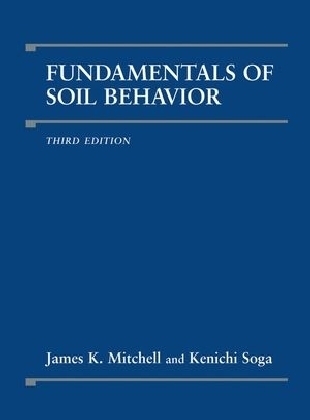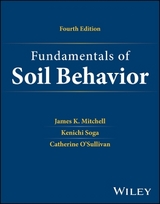
Fundamentals of Soil Behavior
John Wiley & Sons Inc (Verlag)
978-0-471-46302-3 (ISBN)
- Titel erscheint in neuer Auflage
- Artikel merken
The improved, new edition of the classic book on the physical properties of soil
Fundamentals of Soil Behavior, Third Edition is the thoroughly updated, expanded, and revised edition of this highly distinguished publication in geotechnical engineering. Filled with useful tables and graphs illustrating correlations among composition, classification, state, and static and dynamic properties, this Third Edition continues the tradition of providing the latest information on the physical properties of soil and the fundamentals of its behavior over time.
Students and busy professionals will connect with this new edition's timesaving, streamlined format and its greater emphasis on practical exercise problems involving advanced concepts of soil behavior. Other must-read features of this Third Edition include:
New, expanded material on micro-mechanical behavior at the particulate level and its influences on engineering properties at the macro-scale
A new chapter on time effects on soil deformation at different stress and strain levels
New coverage of such important topics as environmental geotechnics, biological influences on soil behavior, soil fracturing, the effects of time, and geochemical problems
Sets of questions and problems at the end of each chapter, a feature not available in prior editions
Fundamentals of Soil Behavior, Third Edition is an essential text for graduate students and researchers as well as a peerless reference for geotechnical, environmental, and civil engineers and geologists.
James K. Mitchell, ScD, is University Distinguished Professor Emeritus in Civil Engineering at the Virginia Polytechnic Institute and State University and Cahill Professor of Civil Engineering, Emeritus, University of California, Berkeley. He serves as a consultant on geotechnical problems and projects to many governmental and private organizations. He is an Honorary Member of the American Society of Civil Engineers and was elected to both the U.S. National Academy of Engineering and Academy of Sciences. Kenichi Soga, PhD, is Reader in Geomechanics. He has been on the faculty at the University of Cambridge, United Kingdom, since 1994. He is an editorial board member of Géotechnique, Journal of Geotechnical and Geoenvironmental Engineering, and Soils and Foundations. He also serves as a member of Engineering and Physical Sciences Research Council Peer Review College and a core member of the Technical Committee on Geotechnics of Particulate Media of the International Society for Soil Mechanics and Geotechnical Engineering.
Preface xi
CHAPTER 1 INTRODUCTION 1
1.1 Soil Behavior in Civil and Environmental Engineering 1
1.2 Scope and Organization 3
1.3 Getting Started 3
CHAPTER 2 SOIL FORMATION 5
2.1 Introduction 5
2.2 The Earth's Crust 5
2.3 Geologic Cycle and Geological Time 6
2.4 Rock and Mineral Stability 7
2.5 Weathering 8
2.6 Origin of Clay Minerals and Clay Genesis 15
2.7 Soil Profiles and Their Development 16
2.8 Sediment Erosion, Transport, and Deposition 18
2.9 Postdepositional Changes in Sediments 25
2.10 Concluding Comments 32
CHAPTER 3 SOIL MINERALOGY 35
3.1 Importance of Soil Mineralogy in Geotechnical Engineering 35
3.2 Atomic Structure 38
3.3 Interatomic Bonding 38
3.4 Secondary Bonds 39
3.5 Crystals and Their Properties 40
3.6 Crystal Notation 42
3.7 Factors Controlling Crystal Structures 44
3.8 Silicate Crystals 45
3.9 Surfaces 45
3.10 Gravel, Sand, and Silt Particles 48
3.11 Soil Minerals and Materials Formed by Biogenic and Geochemical Processes 49
3.12 Summary of Nonclay Mineral Characteristics 49
3.13 Structural Units of the Layer Silicates 49
3.14 Synthesis Pattern and Classification of the Clay Minerals 52
3.15 Intersheet and Interlayer Bonding in the Clay Minerals 55
3.16 The 11 Minerals 56
3.17 Smectite Minerals 59
3.18 Micalike Clay Minerals 62
3.19 Other Clay Minerals 64
3.20 Summary of Clay Mineral Characteristics 65
3.21 Determination of Soil Composition 65
3.22 X-ray Diffraction Analysis 70
3.23 Other Methods for Compositional Analysis 74
3.24 Quantitative Estimation of Soil Components 79
3.25 Concluding Comments 80
CHAPTER 4 SOIL COMPOSITION AND ENGINEERING PROPERTIES 83
4.1 Introduction 83
4.2 Approaches to the Study of Composition and Property Interrelationships 85
4.3 Engineering Properties of Granular Soils 85
4.4 Dominating Influence of the Clay Phase 94
4.5 Atterberg Limits 95
4.6 Activity 97
4.7 Influences of Exchangeable Cations and pH 97
4.8 Engineering Properties of Clay Minerals 98
4.9 Effects of Organic Matter 104
4.10 Concluding Comments 105
CHAPTER 5 SOIL FABRIC AND ITS MEASUREMENT 109
5.1 Introduction 109
5.2 Definitions of Fabrics and Fabric Elements 110
5.3 Single-Grain Fabrics 112
5.4 Contact Force Characterization Using Photoelasticity 119
5.5 Multigrain Fabrics 121
5.6 Voids and Their Distribution 122
5.7 Sample Acquisition and Preparation for Fabric Analysis 123
5.8 Methods for Fabric Study 127
5.9 Pore Size Distribution Analysis 135
5.10 Indirect Methods for Fabric Characterization 137
5.11 Concluding Comments 140
CHAPTER 6 SOIL-WATER-CHEMICAL INTERACTIONS 143
6.1 Introduction 143
6.2 Nature of Ice and Water 144
6.3 Influence of Dissolved Ions on Water 145
6.4 Mechanisms of Soil-Water Interaction 146
6.5 Structure and Properties of Adsorbed Water 146
6.6 Clay-Water-Electrolyte System 153
6.7 Ion Distributions in Clay-Water Systems 153
6.8 Elements of Double-Layer Theory 154
6.9 Influences of System Variables on the Double Layer 157
6.10 Limitations of the Gouy-Chapman Diffuse Double Layer Model 159
6.11 Energy and Force of Repulsion 163
6.12 Long-Range Attraction 164
6.13 Net Energy of Interaction 164
6.14 Cation Exchange--General Considerations 165
6.15 Theories for Ion Exchange 167
6.16 Soil-Inorganic Chemical Interactions 167
6.17 Clay-Organic Chemical Interactions 168
6.18 Concluding Comments 169
CHAPTER 7 EFFECTIVE, INTERGRANULAR, AND TOTAL STRESS 173
7.1 Introduction 173
7.2 Principle of Effective Stress 173
7.3 Force Distributions in a Particulate System 174
7.4 Interparticle Forces 174
7.5 Intergranular Pressure 178
7.6 Water Pressures and Potentials 180
7.7 Water Pressure Equilibrium in Soil 181
7.8 Measurement of Pore Pressures in Soils 183
7.9 Effective and Intergranular Pressure 184
7.10 Assessment of Terzaghi's Equation 185
7.11 Water-Air Interactions in Soils 188
7.12 Effective Stress in Unsaturated Soils 190
7.13 Concluding Comments 193
CHAPTER 8 SOIL DEPOSITS--THEIR FORMATION, STRUCTURE, GEOTECHNICAL PROPERTIES, AND STABILITY 195
8.1 Introduction 195
8.2 Structure Development 195
8.3 Residual Soils 200
8.4 Surficial Residual Soils and Taxonomy 205
8.5 Terrestrial Deposits 206
8.6 Mixed Continental and Marine Deposits 209
8.7 Marine Deposits 209
8.8 Chemical and Biological Deposits 212
8.9 Fabric, Structure, and Property Relationships: General Considerations 213
8.10 Soil Fabric and Property Anisotropy 217
8.11 Sand Fabric and Liquefaction 223
8.12 Sensitivity and Its Causes 226
8.13 Property Interrelationships in Sensitive Clays 235
8.14 Dispersive Clays 239
8.15 Slaking 243
8.16 Collapsing Soils and Swelling Soils 243
8.17 Hard Soils and Soft Rocks 245
8.18 Concluding Comments 245
CHAPTER 9 CONDUCTION PHENOMENA 251
9.1 Introduction 251
9.2 Flow Laws and Interrelationships 251
9.3 Hydraulic Conductivity 252
9.4 Flows Through Unsaturated Soils 262
9.5 Thermal Conductivity 265
9.6 Electrical Conductivity 267
9.7 Diffusion 272
9.8 Typical Ranges of Flow Parameters 274
9.9 Simultaneous Flows of Water, Current, and Salts Through Soil-Coupled Flows 274
9.10 Quantification of Coupled Flows 277
9.11 Simultaneous Flows of Water, Current, and Chemicals 279
9.12 Electrokinetic Phenomena 282
9.13 Transport Coefficients and the Importance of Coupled Flows 284
9.14 Compatibility--Effects of Chemical Flows on Properties 288
9.15 Electroosmosis 291
9.16 Electroosmosis Efficiency 294
9.17 Consolidation by Electroosmosis 298
9.18 Electrochemical Effects 303
9.19 Electrokinetic Remediation 305
9.20 Self-Potentials 305
9.21 Thermally Driven Moisture Flows 307
9.22 Ground Freezing 310
9.23 Concluding Comments 319
CHAPTER 10 VOLUME CHANGE BEHAVIOR 325
10.1 Introduction 325
10.2 General Volume Change Behavior of Soils 325
10.3 Preconsolidation Pressure 327
10.4 Factors Controlling Resistance to Volume Change 330
10.5 Physical Interactions in Volume Change 331
10.6 Fabric, Structure, and Volume Change 335
10.7 Osmotic Pressure and Water Adsorption Influences on Compression and Swelling 339
10.8 Influences of Mineralogical Detail in Soil Expansion 345
10.9 Consolidation 348
10.10 Secondary Compression 353
10.11 In Situ Horizontal Stress (K0) 355
10.12 Temperature-Volume Relationships 359
10.13 Concluding Comments 365
CHAPTER 11 STRENGTH AND DEFORMATION BEHAVIOR 369
11.1 Introduction 369
11.2 General Characteristics of Strength and Deformation 370
11.3 Fabric, Structure, and Strength 379
11.4 Friction Between Solid Surfaces 383
11.5 Frictional Behavior of Minerals 389
11.6 Physical Interactions Among Particles 393
11.7 Critical State: A Useful Reference Condition 400
11.8 Strength Parameters for Sands 404
11.9 Strength Parameters for Clays 411
11.10 Behavior After Peak and Strain Localization 415
11.11 Residual State and Residual Strength 417
11.12 Intermediate Stress Effects and Anisotropy 422
11.13 Resistance to Cyclic Loading and Liquefaction 425
11.14 Strength of Mixed Soils 432
11.15 Cohesion 436
11.16 Fracturing of Soils 438
11.17 Deformation Characteristics 444
11.18 Linear Elastic Stiffness 447
11.19 Transition from Elastic to Plastic States 452
11.20 Plastic Deformation 456
11.21 Temperature Effects 460
11.22 Concluding Comments 462
CHAPTER 12 TIME EFFECTS ON STRENGTH AND DEFORMATION 465
12.1 Introduction 465
12.2 General Characteristics 466
12.3 Time-Dependent Deformation-Structure Interaction 470
12.4 Soil Deformation as a Rate Process 478
12.5 Bonding, Effective Stresses, and Strength 481
12.6 Shearing Resistance as a Rate Process 488
12.7 Creep and Stress Relaxation 489
12.8 Rate Effects on Stress-Strain Relationships 497
12.9 Modeling of Stress-Strain-Time Behavior 503
12.10 Creep Rupture 508
12.11 Sand Aging Effects and Their Significance 511
12.12 Mechanical Processes of Aging 516
12.13 Chemical Processes of Aging 517
12.14 Concluding Comments 520
Questions and Problems 520
List of Symbols 523
References 531
Index 559
| Erscheint lt. Verlag | 15.7.2005 |
|---|---|
| Zusatzinfo | Photos: 23 B&W, 0 Color; Drawings: 541 B&W, 0 Color; Tables: 68 B&W, 0 Color |
| Verlagsort | New York |
| Sprache | englisch |
| Maße | 226 x 282 mm |
| Gewicht | 1315 g |
| Themenwelt | Technik ► Bauwesen |
| ISBN-10 | 0-471-46302-7 / 0471463027 |
| ISBN-13 | 978-0-471-46302-3 / 9780471463023 |
| Zustand | Neuware |
| Informationen gemäß Produktsicherheitsverordnung (GPSR) | |
| Haben Sie eine Frage zum Produkt? |
aus dem Bereich



